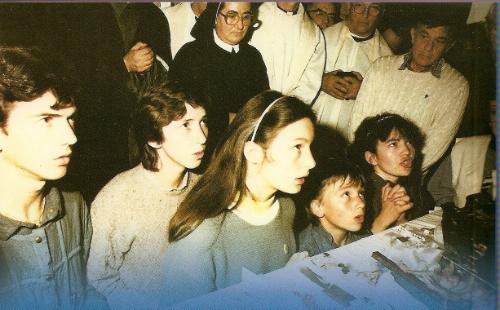MYSTERY OF MEDJUGORJE RISEN CHRIST STATUE
MYSTERY OF MEDJUGORJE RISEN CHRIST STATUE
With liquid dripping from one knee, the bronze sculpture of the Risen Christ has been a mystery in Medjugorje since 2001. While the nature of the liquid is itself mysterious, the mystery as such has just increased, for these days the unknown substance flows from both legs of the sculpture.

Pilgrims standing in line with handkerchiefs, ready to collect drops of the liquid that flows from the Risen Christ sculpture
Almost 11 years after one of the knees of the Risen Christ sculpture in Medjugorje first started to shed a tear-like liquid, even returning pilgrims are surprised by the sculpture these days: Now the watery substance comes from both legs.
“Yes, it is true. Water is coming from both legs now. The new drip is actually just above the knee, on the lower thigh. The new drip is stronger than the older one” film-maker and Queen of Peace Productions founder Sean Bloomfield reports from Medjugorje.

The right leg of the sculpture from where liquid started dripping in 2001
“With all the people in Medjugorje now, having both knees dripping sure helps in the crowd flow!” he adds on the discussion board at where another pilgrim just back from Medjugorje likewise tells to have witnessed the substance dripping from both sculpture legs.
The sculpture has shown to be unpredictable on previous occasions as well. Several times, the dripping has stopped for extended periods of time. One such occasion in 2010 coincided with Medjugorje receiving large amounts of rain, weakening a theory that the watery substance could be rain dripping out from inside the sculpture.
On another occasion, a large group of pilgrims witnessed how the substance was suddenly red and no longer clear:
“My friend Drago who lives in Medjugorje has informed me that this past week a man took a paper napkin and reached to take a drop of oil from the Risen Christ statue. When he looked at the napkin it is reported that the napkin was full of blood. A minimum of 50 people witnessed this. Some screamed in fear and some said, “It’s a miracle” reported by that time.

Gallons of mysterious liquid have been gathered by Medjugorje pilgrims in the course of the almost 11 years when the substance has been flowing from the Risen Christ sculpture behind the outdoor altar of St. James Church
Vatican experts have been rumored to have analyzed the substance, but neither Rome nor the parish of Medjugorje have ever confirmed such analysis to have taken place.
The statue is a replica of the 277 centimeter silver sculpture “The Resurrection”, sculpted by Andrej Ajdic and presented to Pope John Paul II on the occasion of his 1996 visit to Slovenia

